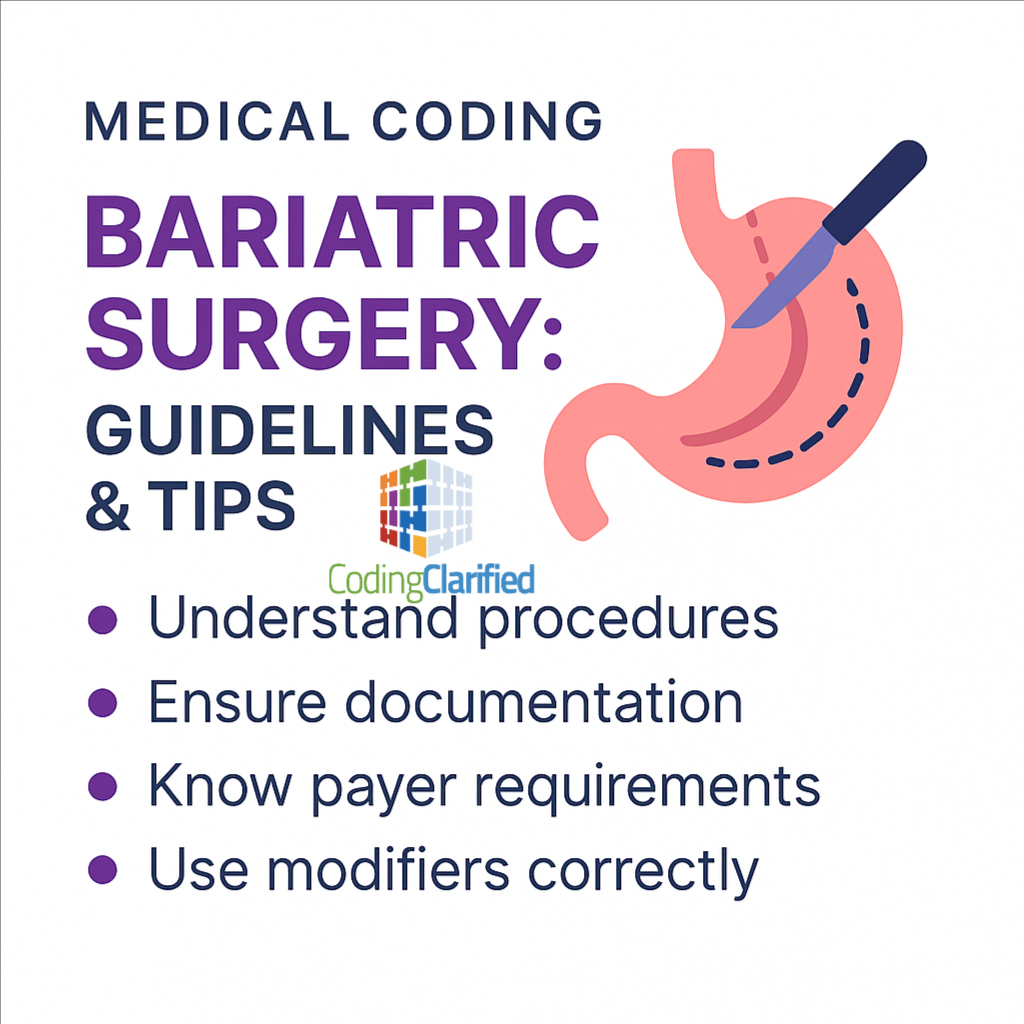Bariatric surgery is a life-changing procedure for patients with morbid obesity, but it also requires precise documentation, coding, and billing to ensure compliance and accurate reimbursement. Medical coders must understand not only the procedures themselves, but also the payer guidelines, documentation requirements, and modifier usage that accompany these cases.
Understanding Bariatric Surgery Procedures
Bariatric (weight-loss) surgeries alter the digestive system to help patients lose weight. The most common procedures include:
-
Gastric Bypass (Roux-en-Y): CPT 43644 (laparoscopic) or 43846 (open).
-
Sleeve Gastrectomy: CPT 43775 (laparoscopic resection of stomach to create sleeve).
-
Adjustable Gastric Banding: CPT 43770 (laparoscopic placement of adjustable gastric band).
-
Biliopancreatic Diversion with Duodenal Switch (BPD/DS): CPT 43845.
Each of these procedures may include variations or revisions, which have distinct CPT codes (for example, 43848 for revision of gastric bypass).
Documentation Requirements
Accurate coding starts with complete documentation. The operative report should clearly specify:
-
The type of bariatric procedure performed (laparoscopic vs. open).
-
Any revisions, removals, or conversions of prior procedures.
-
Whether a gastrointestinal anastomosis was created or revised.
-
The BMI and comorbid conditions that support medical necessity (e.g., hypertension, diabetes, sleep apnea).
Coders should verify that the documentation supports payer criteria for medical necessity before assigning codes.
ICD-10-CM Diagnosis Coding
Diagnosis codes should capture both obesity severity and related comorbidities:
-
E66.01 — Morbid (severe) obesity due to excess calories
-
E66.2 — Morbid obesity with alveolar hypoventilation
-
Z68.43 — BMI 50.0–59.9
-
Z98.84 — Bariatric surgery status (for follow-ups or revisions)
Supporting conditions such as Type 2 diabetes (E11.9) or hypertension (I10) should also be coded when documented.
Payer & Preauthorization Guidelines
Most insurance payers have strict criteria for bariatric surgery approval. Common requirements include:
-
Documentation of failed weight loss attempts through supervised programs
-
Minimum BMI thresholds (≥40 or ≥35 with comorbidities)
-
Psychological and nutritional evaluations
-
Preauthorization with supporting medical necessity documentation
Failure to meet payer criteria can result in claim denials—even if the surgery was performed appropriately.
Modifier & Global Period Considerations
Many bariatric procedures fall under a 90-day global period.
Use modifiers when applicable:
-
Modifier 22: Increased procedural services (for complex revisions)
-
Modifier 52: Reduced services (when part of a planned procedure not performed)
-
Modifier 59: Distinct procedural service (if separate, unrelated procedure performed)
Be sure to follow NCCI edits and payer-specific bundling rules for endoscopy or imaging performed on the same date.
Medical Coding and Billing and the Global Period
Facility vs. Professional Billing
Hospitals bill facility fees under ICD-10-PCS for inpatient cases.
Examples include:
-
0DV64ZZ — Restriction of stomach, percutaneous endoscopic approach (laparoscopic banding)
-
0DV64CZ — Restriction of the stomach using a device, partial occlusion (banding system)
-
0D164ZA — Bypass stomach to jejunum, open approach (Roux-en-Y bypass)
Professional coders bill CPT codes for the surgeon’s services, so both coding systems may apply depending on the setting.
Common Coding Errors to Avoid
-
Confusing laparoscopic and open procedure codes
-
Omitting revision or removal codes when adjustments are made
-
Failing to document medical necessity or BMI
-
Misusing modifiers or unbundling components incorrectly
-
Missing updates to payer-specific coverage policies
Tips for Success
-
Review payer policies regularly for coverage changes.
-
Use operative reports instead of relying solely on the schedule or pre-op documentation.
-
Track denials to identify patterns or recurring documentation issues.
-
Communicate with the surgical team to clarify revisions, complications, or device details.
-
Stay current on CPT and ICD-10 updates—bariatric coding guidelines evolve annually.
In summary: Bariatric surgery coding requires close attention to operative detail, payer requirements, and modifier usage. Accurate documentation and collaboration with providers ensure that claims are processed correctly and reimbursed accurately.
Billing and Coding: Bariatric Surgical Management of Morbid Obesity

